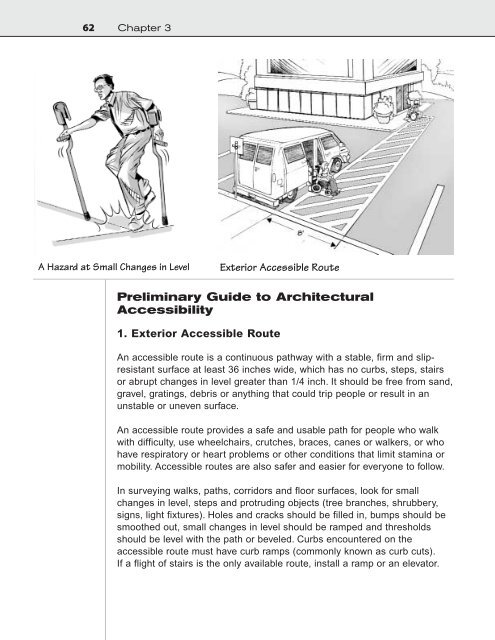Design for Accessibility: A Cultural Administrator's Handbook
Design for Accessibility: A Cultural Administrator's Handbook
Design for Accessibility: A Cultural Administrator's Handbook
Create successful ePaper yourself
Turn your PDF publications into a flip-book with our unique Google optimized e-Paper software.
62 Chapter 3<br />
A Hazard at Small Changes in Level<br />
Exterior Accessible Route<br />
Preliminary Guide to Architectural<br />
<strong>Accessibility</strong><br />
1. Exterior Accessible Route<br />
An accessible route is a continuous pathway with a stable, firm and slipresistant<br />
surface at least 36 inches wide, which has no curbs, steps, stairs<br />
or abrupt changes in level greater than 1/4 inch. It should be free from sand,<br />
gravel, gratings, debris or anything that could trip people or result in an<br />
unstable or uneven surface.<br />
An accessible route provides a safe and usable path <strong>for</strong> people who walk<br />
with difficulty, use wheelchairs, crutches, braces, canes or walkers, or who<br />
have respiratory or heart problems or other conditions that limit stamina or<br />
mobility. Accessible routes are also safer and easier <strong>for</strong> everyone to follow.<br />
In surveying walks, paths, corridors and floor surfaces, look <strong>for</strong> small<br />
changes in level, steps and protruding objects (tree branches, shrubbery,<br />
signs, light fixtures). Holes and cracks should be filled in, bumps should be<br />
smoothed out, small changes in level should be ramped and thresholds<br />
should be level with the path or beveled. Curbs encountered on the<br />
accessible route must have curb ramps (commonly known as curb cuts).<br />
If a flight of stairs is the only available route, install a ramp or an elevator.


